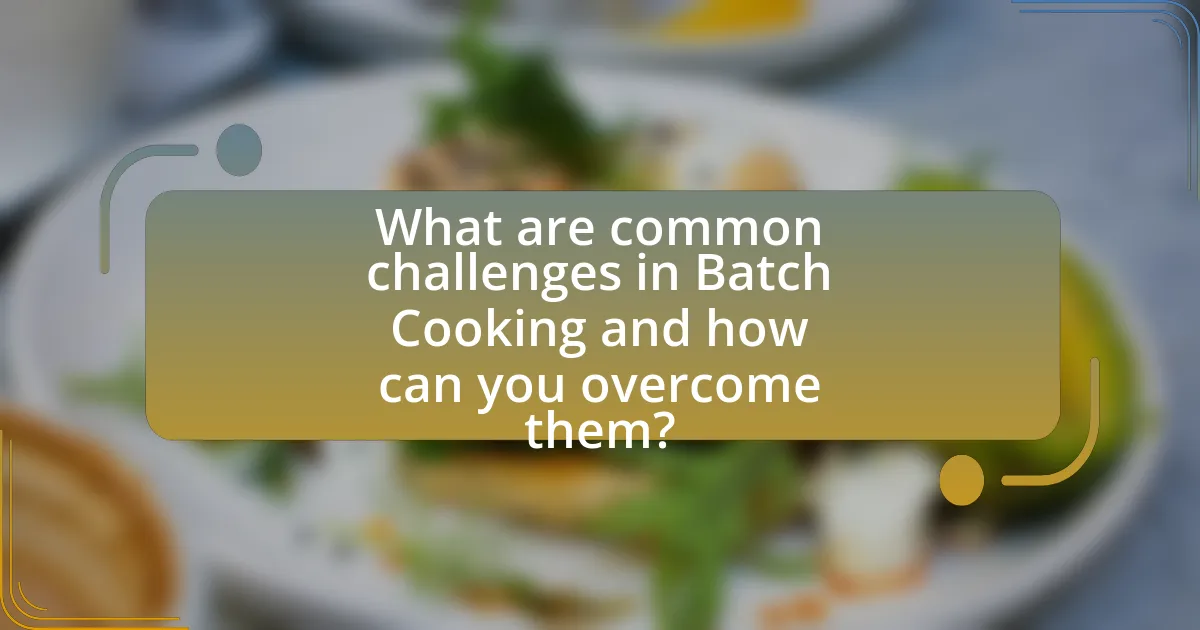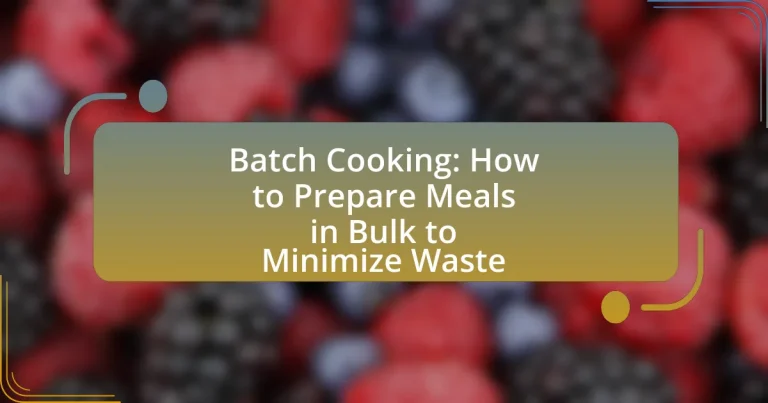Batch cooking is the practice of preparing large quantities of food at once for future consumption, which helps save time, reduce food waste, and lower grocery costs. This article outlines the essential steps involved in batch cooking, including meal planning, ingredient preparation, cooking in bulk, portioning, and proper storage techniques. It also discusses the benefits of batch cooking, such as promoting healthier eating habits and minimizing food waste, as well as strategies for selecting suitable recipes and accommodating dietary needs. Additionally, the article addresses common challenges and mistakes in batch cooking, providing tips for enhancing the overall experience and ensuring food safety.

What is Batch Cooking?
Batch cooking is the practice of preparing large quantities of food at once to be stored and consumed over time. This method allows individuals to save time, reduce food waste, and often save money by buying ingredients in bulk. Studies indicate that batch cooking can lead to healthier eating habits, as it encourages meal planning and reduces the likelihood of opting for unhealthy convenience foods.
How does Batch Cooking work?
Batch cooking involves preparing large quantities of food at once, which can then be stored and consumed over several days. This method typically includes selecting recipes, cooking multiple servings simultaneously, and portioning the meals for future use. By cooking in bulk, individuals can save time, reduce food waste, and often save money by buying ingredients in larger quantities. Studies indicate that batch cooking can lead to a decrease in food waste by up to 30%, as it encourages the use of perishable ingredients before they spoil.
What are the essential steps in Batch Cooking?
The essential steps in batch cooking include planning meals, preparing ingredients, cooking in bulk, portioning meals, and storing them properly. First, planning meals involves selecting recipes that can be made in large quantities and determining the necessary ingredients. Next, preparing ingredients entails washing, chopping, and measuring all components before cooking to streamline the process. Cooking in bulk means preparing multiple servings of the chosen recipes simultaneously, which can save time and energy. After cooking, portioning meals into individual servings helps with easy access and prevents overeating. Finally, storing meals in airtight containers in the refrigerator or freezer ensures freshness and minimizes waste, as proper storage can extend the shelf life of prepared food.
How do you select recipes for Batch Cooking?
To select recipes for batch cooking, prioritize dishes that store well and can be easily reheated. Focus on recipes that utilize similar ingredients to minimize waste and maximize efficiency, such as stews, casseroles, and grain-based salads. Research indicates that meals like chili or vegetable soups can maintain quality for several days in the refrigerator or can be frozen for longer storage, making them ideal for batch cooking.
What are the benefits of Batch Cooking?
Batch cooking offers several benefits, including time savings, cost efficiency, and reduced food waste. By preparing meals in bulk, individuals can streamline their cooking process, allowing for quicker meal preparation throughout the week. This method also leads to financial savings, as buying ingredients in larger quantities often reduces overall grocery costs. Additionally, batch cooking minimizes food waste by ensuring that perishable items are used before they spoil, contributing to more sustainable eating habits. Studies indicate that meal prepping can lead to healthier eating choices, as it encourages the inclusion of balanced ingredients and portion control.
How does Batch Cooking minimize food waste?
Batch cooking minimizes food waste by allowing individuals to prepare large quantities of meals at once, which reduces the likelihood of unused ingredients spoiling. This method encourages the use of perishable items before they expire, as meals are planned around what needs to be consumed soon. Additionally, batch cooking promotes portion control, ensuring that leftovers are minimized and can be stored for future meals, thus preventing excess food from being discarded. Studies indicate that meal planning and preparation can lead to a significant reduction in food waste, with estimates suggesting that households can cut waste by up to 30% through effective batch cooking practices.
What cost savings can be achieved through Batch Cooking?
Batch cooking can achieve significant cost savings by reducing food waste and lowering ingredient expenses. By preparing meals in bulk, individuals can take advantage of bulk purchasing discounts, which often lead to lower per-unit costs for ingredients. Additionally, batch cooking minimizes the likelihood of spoilage, as meals are consumed before ingredients expire, thereby maximizing the value of purchased food. Research indicates that households practicing batch cooking can save up to 30% on their grocery bills compared to those who cook individual meals. This approach not only enhances financial efficiency but also promotes sustainable eating habits by minimizing waste.

What tools and equipment are needed for Batch Cooking?
The tools and equipment needed for batch cooking include large pots, baking sheets, storage containers, a food processor, and measuring cups. Large pots are essential for cooking large quantities of food, while baking sheets are useful for roasting vegetables or proteins in bulk. Storage containers, preferably airtight and stackable, help in organizing and preserving the cooked meals. A food processor can expedite meal prep by chopping or blending ingredients quickly. Measuring cups ensure accurate ingredient portions, which is crucial for consistent results in bulk cooking.
How do you choose the right containers for Batch Cooking?
To choose the right containers for batch cooking, prioritize materials that are durable, microwave-safe, and suitable for both freezing and reheating. Glass containers are ideal as they do not retain odors or stains, while BPA-free plastic options are lightweight and less prone to breakage. Additionally, select containers with airtight lids to prevent spoilage and maintain freshness. Research indicates that using appropriate containers can extend the shelf life of prepared meals by up to 50%, making them essential for effective batch cooking.
What types of containers are best for freezing meals?
The best types of containers for freezing meals are airtight plastic containers, glass containers, and freezer bags. Airtight plastic containers are lightweight, durable, and designed specifically for freezing, preventing freezer burn. Glass containers are non-toxic, reusable, and can withstand temperature changes, making them ideal for freezing and reheating. Freezer bags are flexible, take up less space, and allow for easy removal of air, which helps preserve the quality of the food. These container types are widely recommended by food safety experts for their effectiveness in maintaining food quality during freezing.
How can kitchen appliances enhance the Batch Cooking process?
Kitchen appliances enhance the batch cooking process by increasing efficiency and consistency in meal preparation. For instance, slow cookers allow for hands-off cooking, enabling users to prepare large quantities of meals over extended periods without constant supervision. Food processors expedite chopping, slicing, and dicing, significantly reducing prep time for bulk ingredients. Additionally, pressure cookers can drastically decrease cooking times, allowing for quicker meal preparation while retaining nutrients. These appliances not only streamline the cooking process but also help in portion control and food preservation, which are essential for minimizing waste in batch cooking.
What are the best practices for safe Batch Cooking?
The best practices for safe batch cooking include proper food storage, maintaining appropriate cooking temperatures, and ensuring cleanliness throughout the cooking process. Proper food storage involves refrigerating or freezing cooked meals within two hours to prevent bacterial growth, as food left at room temperature can become unsafe after this period. Maintaining cooking temperatures is crucial; foods should be cooked to safe internal temperatures—typically 165°F (74°C) for poultry and 145°F (63°C) for fish—to eliminate harmful pathogens. Cleanliness is essential; hands, utensils, and surfaces should be washed frequently to avoid cross-contamination, as recommended by the USDA. Following these practices minimizes the risk of foodborne illnesses and ensures that meals remain safe for consumption.
How do you ensure food safety during Batch Cooking?
To ensure food safety during batch cooking, maintain proper temperature control throughout the cooking and storage process. Cooking food to the appropriate internal temperature kills harmful bacteria, while promptly cooling and refrigerating leftovers prevents bacterial growth. The USDA recommends cooking meats to specific temperatures, such as 165°F for poultry and 145°F for whole cuts of beef, pork, and lamb. Additionally, food should be cooled from 140°F to 70°F within two hours and then to 40°F or below within an additional four hours to minimize the risk of foodborne illness.
What are the guidelines for storing and reheating meals?
To store and reheat meals safely, keep cooked food in airtight containers and refrigerate within two hours of cooking. The USDA recommends consuming refrigerated meals within three to four days to prevent bacterial growth. When reheating, ensure food reaches an internal temperature of 165°F (74°C) to kill any harmful bacteria. Use a food thermometer for accuracy, and avoid reheating multiple times, as this increases the risk of foodborne illness.

How can you effectively plan your Batch Cooking sessions?
To effectively plan your batch cooking sessions, start by selecting recipes that share similar ingredients to minimize waste and streamline preparation. This approach allows for efficient use of resources and reduces the time spent on cooking. Additionally, create a detailed shopping list based on the chosen recipes to ensure you have all necessary ingredients on hand, which can prevent last-minute trips to the store. Organizing your cooking schedule by allocating specific days for preparation and cooking can further enhance efficiency. Research indicates that planning meals in advance can lead to healthier eating habits and reduced food waste, as noted in a study published in the Journal of Nutrition Education and Behavior.
What factors should you consider when planning meals?
When planning meals, consider nutritional balance, dietary restrictions, ingredient availability, and portion sizes. Nutritional balance ensures meals provide essential vitamins and minerals, while dietary restrictions accommodate allergies or preferences, such as vegetarianism. Ingredient availability affects meal choices based on seasonal produce or local markets, and portion sizes help minimize waste by aligning with consumption patterns. Research indicates that meal planning can reduce food waste by up to 50%, highlighting the importance of these factors in effective meal preparation.
How do you create a balanced meal plan for Batch Cooking?
To create a balanced meal plan for batch cooking, include a variety of food groups such as proteins, whole grains, fruits, and vegetables in each meal. This ensures that meals provide essential nutrients and maintain dietary balance. For example, a meal could consist of grilled chicken (protein), quinoa (whole grain), steamed broccoli (vegetable), and a side of mixed berries (fruit). Research indicates that a balanced diet can improve overall health and reduce the risk of chronic diseases, supporting the importance of including diverse food groups in meal planning.
What is the importance of meal variety in Batch Cooking?
Meal variety in batch cooking is crucial for maintaining nutritional balance and preventing meal fatigue. A diverse range of meals ensures that individuals receive a wide array of nutrients essential for health, as different foods provide different vitamins and minerals. Research indicates that a varied diet can improve overall dietary quality and satisfaction, which is particularly important in batch cooking where meals are prepared in advance. By incorporating various ingredients and flavors, individuals are more likely to enjoy their meals, leading to better adherence to healthy eating habits.
How can you adapt Batch Cooking to dietary needs?
To adapt batch cooking to dietary needs, individuals should customize recipes to align with specific dietary restrictions or preferences, such as gluten-free, vegan, or low-carb. This can be achieved by substituting ingredients that do not meet dietary requirements with suitable alternatives; for example, using quinoa instead of rice for a gluten-free option or replacing animal proteins with legumes for a vegan meal. Additionally, portioning meals according to caloric or nutritional guidelines can help meet individual dietary goals. Research indicates that meal planning and preparation can significantly reduce food waste while accommodating diverse dietary needs, as evidenced by a study published in the Journal of Nutrition Education and Behavior, which highlights the effectiveness of tailored meal prep in promoting healthier eating habits.
What strategies can be used for vegetarian or vegan Batch Cooking?
Vegetarian or vegan batch cooking can be effectively achieved through several strategies, including meal planning, ingredient preparation, and proper storage techniques. Meal planning involves selecting recipes that utilize similar ingredients, which minimizes waste and maximizes efficiency. Ingredient preparation includes washing, chopping, and cooking vegetables in advance, allowing for quicker assembly during the week. Proper storage techniques, such as using airtight containers and labeling meals with dates, ensure food safety and maintain freshness. These strategies are supported by studies indicating that meal prepping can reduce food waste by up to 50%, as it encourages the use of perishable items before they spoil.
How do you accommodate food allergies in Batch Cooking?
To accommodate food allergies in batch cooking, it is essential to identify and eliminate allergens from recipes. This involves carefully reading ingredient labels, using separate utensils and containers for allergen-free meals, and preparing allergen-free dishes first to avoid cross-contamination. Research indicates that approximately 32 million Americans have food allergies, highlighting the importance of these precautions in meal preparation. By implementing these strategies, batch cooking can be safely enjoyed by individuals with food allergies.

What are common challenges in Batch Cooking and how can you overcome them?
Common challenges in batch cooking include time management, ingredient storage, and meal variety. To overcome time management issues, plan meals in advance and allocate specific cooking days, which can streamline the process. For ingredient storage, use airtight containers to maintain freshness and label items with dates to avoid spoilage. To address meal variety, create a diverse menu that incorporates different cuisines and cooking methods, ensuring that meals remain appealing over time. These strategies can enhance the efficiency and enjoyment of batch cooking.
What are the most frequent mistakes made in Batch Cooking?
The most frequent mistakes made in batch cooking include improper meal planning, inadequate storage techniques, and neglecting food safety practices. Improper meal planning often leads to cooking too much or too little, resulting in wasted ingredients or insufficient meals. Inadequate storage techniques, such as using unsuitable containers or not labeling meals, can cause food spoilage or confusion about what is available. Neglecting food safety practices, like not cooling food quickly enough or failing to reheat it to safe temperatures, increases the risk of foodborne illnesses. These mistakes can significantly undermine the efficiency and effectiveness of batch cooking, ultimately defeating its purpose of minimizing waste.
How can you avoid overcooking or undercooking meals?
To avoid overcooking or undercooking meals, use a food thermometer to accurately monitor internal temperatures. Cooking meats to the recommended temperatures—such as 165°F for poultry and 145°F for pork—ensures safety and proper doneness. Additionally, timing is crucial; follow specific cooking times for each ingredient and adjust based on portion sizes. For example, vegetables typically require less cooking time than grains. By utilizing these methods, you can achieve consistent results and prevent food waste associated with improperly cooked meals.
What should you do if meals do not taste fresh after freezing?
If meals do not taste fresh after freezing, you should enhance their flavor by adding fresh herbs, spices, or a splash of citrus juice when reheating. This method revitalizes the taste, compensating for any flavor loss that may occur during the freezing process. Research indicates that freezing can lead to changes in texture and flavor due to ice crystal formation, which can affect the overall quality of the meal. Therefore, incorporating fresh ingredients during reheating can effectively restore the meal’s original taste profile.
What tips can enhance your Batch Cooking experience?
To enhance your batch cooking experience, plan your meals in advance and create a detailed shopping list. This approach ensures you have all necessary ingredients, reducing the likelihood of last-minute trips to the store, which can disrupt your cooking schedule. Additionally, using versatile ingredients allows for the creation of multiple dishes, maximizing efficiency and minimizing waste. Research indicates that meal planning can save time and reduce food waste by up to 30%, as it encourages the use of ingredients before they spoil.
How can you streamline your Batch Cooking process?
To streamline your batch cooking process, plan your meals in advance and create a detailed shopping list. This approach minimizes time spent deciding what to cook and ensures you have all necessary ingredients on hand. Research indicates that meal planning can reduce food waste by up to 30%, as it encourages the use of ingredients before they spoil. Additionally, using a single cooking method for multiple dishes, such as roasting or slow cooking, can save time and energy, further enhancing efficiency in the kitchen.
What are some creative ways to repurpose leftovers from Batch Cooking?
Repurposing leftovers from batch cooking can be achieved through various creative methods. One effective way is to transform leftover proteins, such as chicken or beef, into stir-fries or tacos, enhancing flavors with fresh vegetables and sauces. Another method involves using leftover grains, like rice or quinoa, to create salads or grain bowls, incorporating different dressings and toppings for variety. Additionally, soups can be made by combining leftover vegetables and proteins with broth, providing a hearty meal option. These approaches not only minimize waste but also offer diverse meal choices, making the most of batch-cooked ingredients.


